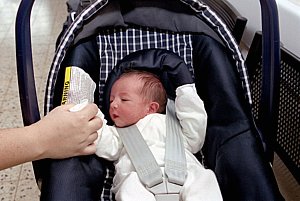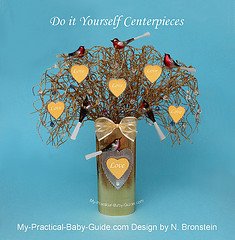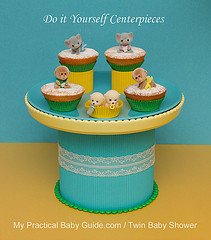Rear-Facing Infant Car Seat
|
| The American Academy of Pediatrics recommends that all infants discharged from hospitals be brought home in infant rear facing car seats. They should keep rear-facing until they reach the highest weight or height allowed by their car safety seat’s manufacturer. |
New AAP Car Seat Safety Guidelines: Rear-Facing Until Age 2
In a new policy statement published in the April 2011 issue of Pediatrics, the American Academy of Pediatrics now advises parents to keep toddlers in rear-facing car seats until age two, or until they exceed the height or weight limit for the car seat, which can be found on the back of the seat.
Previously, the AAP advised that at a minimum, infants should ride rear-facing until they have reached at least 1 year of age and weigh at least 20 pounds.
The AAP still recommends to keep your child rear-facing as long as possible, and that may mean up to 35 or 40 pounds for most convertible car seats.
When infants reach the highest weight or length allowed by the manufacturer of their infant-only seat, they should continue to ride rear-facing in a convertible seat.
Types of Rear Facing Car Seat
There are 2 types of rear-facing car safety seats: infant-only seats and convertible seats. When children reach the highest weight or length allowed by the manufacturer of their infant-only seat, they should continue to ride rear-facing in a convertible seat.Infant-only seats
| | Are used for infants up to 22 to 35 pounds, depending on the model. |
| | Have carrying handles. |
| | Some may come as part of a stroller system. |
| | May come with a base that can be left in the car. |
Removable infant car seat is my favorite for these reasons :
| | You do not need to wake up your baby to take him/her in and out of the seat. |
| | The seat clicks into and out of the base so you don’t have to install the seat each time you use it. |
| | Parents can buy more than one base for additional vehicles. |
Convertible seats (used rear-facing)
| | Can be used as rear-facing, then "converted" to forward-facing for older children. This means the seat can be used longer by your child. |
| | Have higher rear-facing weight and height limits than infant-only seats, which make them ideal for bigger babies. |
| | They do not come with carrying handles or a separate base. |
How to install an infant car seat?
| | The safest place for all children to ride is in the back seat. |
| | The seat must be buckled tightly into your vehicle and your child must be buckled snugly into the seat. |
| | Never place a child in a rear-facing car safety seat in the front seat of a vehicle that has a passenger air bag. |
| | Always follow the manufacturer’s instructions which outline proper installation and usage. If you don’t have the instructions, contact the manufacturer for a replacement copy. |
Go to seatcheck.org and type in your zip code to find the nearest inspection locations, there are more than 33,000 CPSTs nationwide.
Used or New Car Seat
It is very tempting to buy used car seat in order to save money but always remember your baby's safety is above all.Before buying or using secondhand car seat, read the following recommendations:
| | Avoid using secondhand car safety seat from sources like yard sale or thrift shop, because there is no way to know the seat’s history. |
| | Most manufacturers recommend that car safety seats only be used for a certain number of years. Car safety seats become worn after a short use and may be missing important parts, labels, or instructions. |
| | Secondhand seats may have damage that you cannot see, or may have been recalled. |
Shopping online for infant safety car seat
If you want to save your money, consider buying your infant safety car seat online.I also recommend to check your local baby store and compare prices.
Take a moment and check these online offers, usually you can save quite a lot.
Or use this Practical Search Box to compare prices

Before you buy check our Product Recalls Finder for the latest recalls .

General safety guidelines recommended by the AAP:
| | It is preferable to place infant or children car seats in the backseat because it is the safest. |
| | Never use a rear-facing car safety seat in the front seat of a vehicle equipped with a passenger-side air bag. |
| | An infant or child should never ride in an adult’s arms. |
| | Children age twelve and younger should ride in the rear seat. |
Return from Rear-Facing Infant Car Seat to Baby Safety and Childproofing
Let Google Know You Like This Page, Just Click g+
Like what you see?
Follow me
Email Newsletter
Subscribe to our free email newsletter to stay up to date regarding Pregnancy, Baby Shower, Labor & Babies.
New
Winnie the Pooh Games
New
Tutorials
Baby Shower Favors To Make
New Tutorial
Merry Go Round
New
Wishing Tree Ideas
New
DIY Themed Centerpieces










We will be more than glad if you leave your comments in the box below.